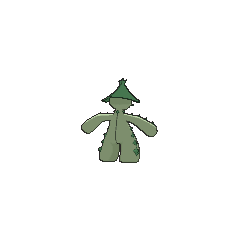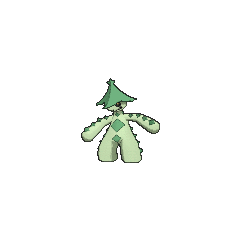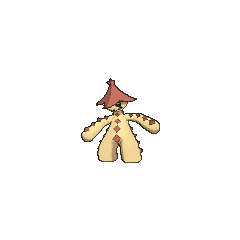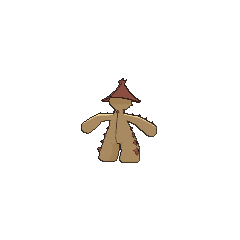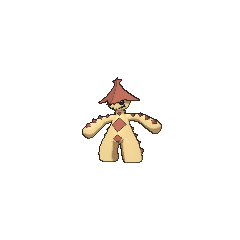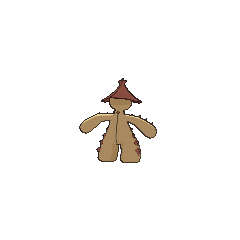|
|
| Line 43: |
Line 43: |
|
| |
|
| ==Biology== | | ==Biology== |
| Cacturne is a humanoid, bipedal Pokémon that resembles a green scarecrow made of cacti. It has yellow eyes and its mouth is composed of holes on its face. It has numerous spikes along the length of its arms, legs, and neck. A pattern of green rhombi extends down the front of its body. A female has a big, dark green rhombus on its chest, while a male has two small dark green rhombi. There is triangular, dark green feature on its head that resembles a hat with spiky tips. | | Cacturne is a humanoid, bipedal Pokémon that resembles a green scarecrow made of cacti. Its face has two eye holes through which yellow eyes can be seen, and six smaller holes representing a grinning mouth. It has numerous spikes along the length of its arms, legs, and around its neck. A pattern of green rhombi extends down the front of its body. A female has a large dark green rhombus above a smaller one, while a male has three small dark green rhombi. There is triangular, dark green feature on its head that resembles a hat with spiky tips. |
|
| |
|
| Cacturne is a nocturnal Pokémon that rarely moves during the day, which allows it to hold moisture. At night, it searches for prey or follows travelers until they become exhausted. It has lived in {{DL|List of Pokémon by habitat|Rough-terrain Pokémon|deserts}} for so long that its blood has transformed into sand. With its thorny arms, it is able to use its former [[signature move]], {{m|Needle Arm}}. | | Cacturne is a nocturnal Pokémon that rarely moves during the day, which allows it to hold moisture. At night, it searches for prey or follows travelers until they become exhausted. It has lived in {{DL|List of Pokémon by habitat|Rough-terrain Pokémon|deserts}} for so long that its blood has transformed into sand. With its thorny arms, it is able to use its former [[signature move]], {{m|Needle Arm}}. |
| Line 412: |
Line 412: |
|
| |
|
| ===Origin=== | | ===Origin=== |
| Cacturne is based on a {{wp|cactus}}, possibly the {{wp|saguaro}}, and a {{wp|scarecrow}}. It could be associated with nighttime because Cacti are known as night (CAM) plants, as their CO<sub>2</sub> fixation process occurs during the night. | | Cacturne is based on a {{wp|cactus}}, possibly the {{wp|saguaro}}, and a {{wp|scarecrow}}. It could be associated with nighttime because Cacti are known as night (CAM) plants, as their CO<sub>2</sub> fixation process occurs during the night. Its face is similar to a classic Halloween jack-'o-lantern, referencing the tendency for scarecrows to have pumpkins for heads. |
|
| |
|
| ====Name origin==== | | ====Name origin==== |
| Cacturne is a combination of ''{{wp|cactus}}'' and ''{{wp|nocturne (painting)|nocturne}}'' or ''{{wp|nocturnal}}''. It may also involve ''{{wp|tricorne}}'', referring to its head shape. | | Cacturne is a combination of ''{{wp|cactus}}'' and ''{{wp|nocturne (painting)|nocturne}}''. |
|
| |
|
| Noctus is a combination of ''nocturne'' or ''nocturnal'' and ''cactus''. | | Noctus is a combination of ''nocturne'' or ''nocturnal'' and ''cactus''. |
Cacturne (Japanese: ノクタス Noctus) is a dual-type Grass/Dark Pokémon.
It evolves from Cacnea starting at level 32.
Biology
Cacturne is a humanoid, bipedal Pokémon that resembles a green scarecrow made of cacti. Its face has two eye holes through which yellow eyes can be seen, and six smaller holes representing a grinning mouth. It has numerous spikes along the length of its arms, legs, and around its neck. A pattern of green rhombi extends down the front of its body. A female has a large dark green rhombus above a smaller one, while a male has three small dark green rhombi. There is triangular, dark green feature on its head that resembles a hat with spiky tips.
Cacturne is a nocturnal Pokémon that rarely moves during the day, which allows it to hold moisture. At night, it searches for prey or follows travelers until they become exhausted. It has lived in deserts for so long that its blood has transformed into sand. With its thorny arms, it is able to use its former signature move, Needle Arm.
In the anime
Major appearances
Harley owns a Cacturne. It first appeared in A Cacturne for the Worse, and has been Harley's main and best Pokémon since.
Minor appearances
Cacturne made its debut in a cameo appearance in Destiny Deoxys.
Pokédex entries
| Episode
|
Pokémon
|
Source
|
Entry
|
| AG103
|
Cacturne
|
May's Pokédex
|
Cacturne, the Scarecrow Pokémon. Cacturne is the evolved form of Cacnea, and has traits of both Grass and Dark types. It rarely moves during the day, but is active once the temperature drops at night.
|
|
In the manga
In the Pokémon Adventures manga
Cacturne first appears in Talk About Timing, Treecko, under the ownership of Wally. He was first seen when he was rowing a boat during a flood caused by Kyogre.
In the TCG
- Main article: Cacturne (TCG)
Game data
Pokédex entries
| This Pokémon was unavailable prior to Generation III.
|
| Generation III
|
|
| Ruby
|
During the daytime, Cacturne remains unmoving so that it does not lose any moisture to the harsh desert sun. This Pokémon becomes active at night when the temperature drops.
|
| Sapphire
|
If a traveler is going through a desert in the thick of night, Cacturne will follow in a ragtag group. The Pokémon are biding their time, waiting for the traveler to tire and become incapable of moving.
|
| Emerald
|
After spending thousands of years in harsh deserts, its blood transformed into the same substances as sand. It is nocturnal, so it hunts at night.
|
| FireRed
|
It lives in deserts. It becomes active at night when it hunts for prey exhausted from the desert's heat.
|
| LeafGreen
|
|
|
| Generation IV
|
|
| Diamond
|
It becomes active at night, seeking prey that is exhausted from the day's desert heat.
|
| Pearl
|
| Platinum
|
| HeartGold
|
Packs of them follow travelers through the desert until the travelers can no longer move.
|
| SoulSilver
|
|
|
| Generation V
|
|
| Black
|
It becomes active at night, seeking prey that is exhausted from the day's desert heat.
|
| White
|
| Black 2
|
It becomes active at night, seeking prey that is exhausted from the day's desert heat.
|
| White 2
|
|
|
| Generation VI
|
|
| X
|
It becomes active at night, seeking prey that is exhausted from the day's desert heat.
|
| Y
|
Packs of them follow travelers through the desert until the travelers can no longer move.
|
| Omega Ruby
|
During the daytime, Cacturne remains unmoving so that it does not lose any moisture to the harsh desert sun. This Pokémon becomes active at night when the temperature drops.
|
| Alpha Sapphire
|
If a traveler is going through a desert in the thick of night, Cacturne will follow in a ragtag group. The Pokémon are biding their time, waiting for the traveler to tire and become incapable of moving.
|
|
|
Game locations
| This Pokémon was unavailable prior to Generation III.
|
|
|
|
|
|
|
|
|
In side games
| This Pokémon was unavailable prior to Generation III.
|
|
|
|
|
|
|
|
|
In events
Held items
Stats
Base stats
| Stat
|
Range
|
| At Lv. 50
|
At Lv. 100
|
70
|
|
130 - 177
|
250 - 344
|
115
|
|
108 - 183
|
211 - 361
|
60
|
|
58 - 123
|
112 - 240
|
115
|
|
108 - 183
|
211 - 361
|
60
|
|
58 - 123
|
112 - 240
|
55
|
|
54 - 117
|
103 - 229
|
Total: 475
|
Other Pokémon with this total
|
- Minimum stats are calculated with 0 EVs, IVs of 0, and (if applicable) a hindering nature.
- Maximum stats are calculated with 252 EVs, IVs of 31, and (if applicable) a helpful nature.
|
Pokéathlon stats
Type effectiveness
| Under normal battle conditions in Generation IX, this Pokémon is:
|
|
|
|
|
|
|
|
|
|
|
|
|
Learnset
|
|
|
|
- Bold indicates a move that gets STAB when used by Cacturne
- Italic indicates a move that gets STAB only when used by an Evolution of Cacturne
- Click on the generation numbers at the top to see level-up moves from other generations
|
|
|
|
|
- Bold indicates a move that gets STAB when used by Cacturne
- Italic indicates a move that gets STAB only when used by an Evolution of Cacturne
- Click on the generation numbers at the top to see TM moves from other generations
|
|
|
|
|
- Moves marked with an asterisk (*) must be chain bred onto Cacturne in Generation VI
- Moves marked with a double dagger (‡) can only be bred from a Pokémon who learned the move in an earlier generation.
- Moves marked with a superscript game abbreviation can only be bred onto Cacturne in that game.
- Bold indicates a move that gets STAB when used by Cacturne
- Italic indicates a move that gets STAB only when used by an Evolution of Cacturne
- Click on the generation numbers at the top to see Egg moves from other generations
|
|
|
|
|
- A black or white abbreviation in a colored box indicates that Cacturne can be tutored the move in that game
- A colored abbreviation in a white box indicates that Cacturne cannot be tutored the move in that game
- Bold indicates a move that gets STAB when used by Cacturne
- Italic indicates a move that gets STAB only when used by an Evolution of Cacturne
- Click on the generation numbers at the top to see Move Tutor moves from other generations
|
|
|
|
|
- Bold indicates a move that gets STAB when used by Cacturne
- Italic indicates a move that gets STAB only when used by an Evolution of Cacturne
- Click on the generation numbers at the top to see moves from other generations
|
TCG-only moves
Side game data
Evolution
Sprites
| This Pokémon was unavailable prior to Generation III.
|
|
|
|
|
|
|
|
|
Trivia
Origin
Cacturne is based on a cactus, possibly the saguaro, and a scarecrow. It could be associated with nighttime because Cacti are known as night (CAM) plants, as their CO2 fixation process occurs during the night. Its face is similar to a classic Halloween jack-'o-lantern, referencing the tendency for scarecrows to have pumpkins for heads.
Name origin
Cacturne is a combination of cactus and nocturne.
Noctus is a combination of nocturne or nocturnal and cactus.
In other languages
| Language
|
Title
|
Meaning
|
 Japanese Japanese
|
ノクタス Noctus
|
From nocturne or nocturnal and cactus
|
 French French
|
Cacturne
|
Same as English name
|
 Spanish Spanish
|
Cacturne
|
Same as English name
|
 German German
|
Noktuska
|
From nocturne and Kaktus (Tuska)
|
 Italian Italian
|
Cacturne
|
Same as English name
|
 Korean Korean
|
밤선인 Bamseonin
|
From 밤 bam and 선인장 (仙人掌) seon-in-jang
|
 Mandarin Chinese Mandarin Chinese
|
夢歌奈亞 / 梦歌奈亚
Mènggēnàiyǎ / Mènggēnàiyà
|
From 夢歌 mènggē and 奈亞 nàiyǎ
|
 Cantonese Chinese Cantonese Chinese
|
|
|
|
|
|
|
|
|
|
Related articles
External links

|
This Pokémon article is part of Project Pokédex, a Bulbapedia project that aims to write comprehensive articles on each Pokémon species, as well as Pokémon groups and forms.
|
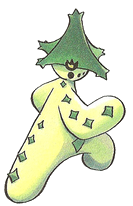
 For other sprites and images, please see Cacturne images on the Bulbagarden Archives.
For other sprites and images, please see Cacturne images on the Bulbagarden Archives.

























































































